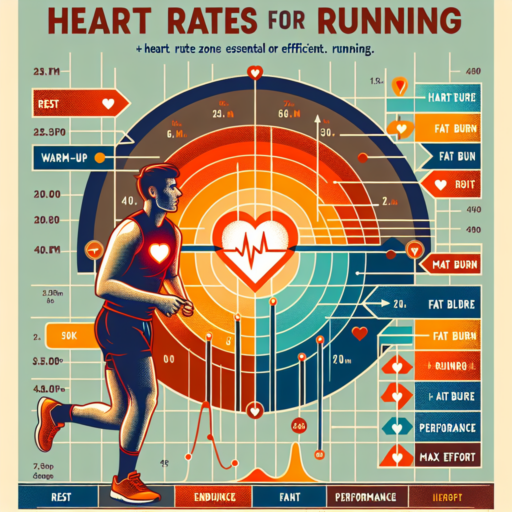Understanding Heart Rate Zones for Running
When engaging in running as a form of exercise, it’s crucial to understand the concept of heart rate zones and how they impact your training efficiency and overall cardiovascular health. Heart rate zones are directly linked to the intensity levels of your workouts and are indicators of how hard your heart is working. Grasping the nuances of these zones can make a significant difference in achieving your running goals, whether they aim at increasing stamina, losing weight, or improving heart health.
The basic principle behind heart rate zones is relatively straightforward. These zones are typically divided into five distinct categories, ranging from very light intensity to maximum effort. Each zone is tailored to elicit specific physiological responses and benefits. For instance, Zone 1 represents a very comfortable effort level, often referred to as the «warm-up» or «recovery» zone, where you should be able to hold a conversation easily. As you move up to Zone 2, your body begins to increase fat utilization, making it optimal for endurance training and weight management.
Moving into Zone 3 and Zone 4, the intensity level increases, focusing more on improving cardiovascular and respiratory strength. These zones are where you feel your breathing become heavier and maintaining a conversation becomes more challenging. Training in these zones is crucial for boosting your aerobic capacity and improving running speed. The highest intensity, Zone 5, is where effort level is at its peak. Training in this zone should be done sparingly as it stresses the body to its limits, but it’s essential for improving speed and power.
The Five Heart Rate Zones Explained
Understanding the five heart rate zones is crucial for anyone looking to optimize their workout, whether you’re a seasoned athlete or just starting your fitness journey. These zones are calculated based on a percentage of your maximum heart rate (MHR) and can help you tailor your exercise routine to achieve specific fitness goals, such as improving endurance or burning fat.
Zone 1: Light Intensity
Zone 1 activities are very gentle and purpose to improve overall health and recovery. Operating at 50-60% of your MHR, workouts in this zone are comfortable and can be sustained for long periods. They are ideal for warming up, cooling down, or for recovery days.
Zone 2: Moderate Intensity
In Zone 2, you work at 60-70% of your MHR, a range perfect for endurance training. This moderate intensity is where you can talk comfortably while exercising, enhancing cardiovascular health and efficiency. Spending time in this zone helps in fat burning and improves aerobic capacity.
Zone 3: Hard Intensity
Zone 3 pushes you to 70-80% of your MHR. Expect to find it challenging to maintain conversations at this level. Exercises in this zone boost your aerobic fitness and begin to build anaerobic stamina, preparing your body for more intense workouts.
How to Calculate Your Running Heart Rate Zones
Understanding your running heart rate zones is crucial for optimizing your fitness regime. It not only helps in enhancing your performance but also in preventing overtraining and potential injuries. The concept revolves around dividing your heart rate into different zones, each representing a different level of intensity. To calculate these zones accurately, you need to first determine your Maximum Heart Rate (MHR). A popular method to estimate your MHR is by subtracting your age from 220. Once you have your MHR, you can then calculate your heart rate zones, which are typically broken down into percentages of your MHR.
Step-by-Step Guide to Calculate Your Heart Rate Zones
To dive deeper into calculating your running heart rate zones, follow a structured approach. Start by establishing your MHR using the formula 220 – age. With your MHR known, you can then determine the five commonly used heart rate zones. For instance:
- Zone 1: 50-60% of MHR – This zone is great for beginners or for recovery runs.
- Zone 2: 60-70% of MHR – Ideal for long, slow runs where the goal is to burn fat efficiently.
- Zone 3: 70-80% of MHR – Targets aerobic fitness improvements.
- Zone 4: 80-90% of MHR – Focuses on increasing your lactate threshold, which is crucial for faster running.
- Zone 5: 90-100% of MHR – Used for interval training to improve speed and power.
Calculating your running heart rate zones is an empirical process that gives you insights into different training intensities. It’s vital to remember that these calculations are based on estimates and can vary based on fitness levels, health condition, and individual differences. Regularly updating your MHR and heart rate zones will ensure that your training remains effective and tailored to your current fitness status.
The Benefits of Training in Different Heart Rate Zones
Understanding and leveraging the different heart rate zones is a powerful approach to optimizing your workout routine for a variety of goals. Whether you’re aiming to improve cardiovascular health, increase stamina, or burn fat more efficiently, tailoring your training to these specific zones can yield significant benefits.
Boosting Cardiovascular Health
Training in various heart rate zones, especially those that challenge your cardiovascular system, can lead to significant improvements in heart health. By frequently oscillating between moderate and high-intensity zones, you encourage your heart to become more efficient at pumping blood. This not only improves your overall endurance but also helps in reducing the risk of heart-related diseases.
Enhanced Fat Burning
Another significant advantage is the enhanced ability to burn fat. Working out in the lower heart rate zones, particularly the fat-burning zone, allows your body to use fat as its primary source of energy. This approach can be incredibly beneficial for those looking to lose weight or manage their body composition effectively.
Improving Athletic Performance
For athletes, the strategic training across different heart rate zones can lead to marked improvements in performance. High-intensity interval training (HIIT), which often involves reaching higher heart rate zones, enhances VO2 max and contributes to faster recovery times. This method prepares athletes to perform at their best under pressure, improving both speed and endurance.
Applying Heart Rate Zones to Your Running Routine
Integrating heart rate zones into your running routine can significantly enhance your training efficiency and overall cardiovascular health. Understanding heart rate zones allows runners to tailor their workouts more precisely, aiming at distinct objectives such as fat burning, endurance building, or improving aerobic capacity. Each heart rate zone reflects a percentage of your maximum heart rate (MHR), eliciting various physiological benefits that are critical to your running performance and adaptation.
Identifying Your Heart Rate Zones
Typically, heart rate zones are divided into five categories ranging from very light intensity to maximum effort. Zone 1 is where you’re at 50-60% of your MHR, which is ideal for warming up and cooling down. Zone 2 (60-70% of MHR) focuses on fat burning and recovery runs. Zone 3 (70-80% of MHR) enhances aerobic capacity, while Zone 4 (80-90% of MHR) pushes the boundaries of your anaerobic threshold. Finally, Zone 5 (90-100% of MHR) is where high-intensity interval training (HIIT) sessions reside, drastically improving speed and power.
Applying Zones to Improve Performance
To effectively apply heart rate zones to your running routine, start by determining your MHR through a standardized test or an estimated formula, such as 220 minus your age. After establishing your MHR, you can calculate the heart rate ranges for each zone. Tailoring your running sessions according to these zones can optimize your training outcomes. For example, alternating days between Zone 2 runs for recovery and Zone 4 intervals for speed enhancement can create a balanced training schedule that maximizes both fat burning and aerobic and anaerobic capabilities.
No se han encontrado productos.
Monitoring Your Heart Rate While Running: Tools and Tips
Monitoring your heart rate while running is not just about tracking how fast your heart is beating. It’s a proactive way to gauge your workout intensity, ensure you’re training within the right zones, and prevent overexertion. With the right tools and insights, you can optimize your runs, making them more effective and safer.
Choosing the Right Tool for Heart Rate Monitoring
The foundation of effective heart rate monitoring is selecting the appropriate gadget. Devices such as chest strap monitors and smartwatches are popular among runners due to their accuracy and convenience. Chest straps are celebrated for their precision and constant contact with the skin, offering real-time insights. On the other hand, smartwatches provide a more comfortable, albeit slightly less precise, alternative. They also offer the added benefits of GPS tracking and performance analytics, making them a versatile option for runners at all levels.
Understanding Your Heart Rate Zones
Knowing what your heart rate should be during different phases of your run is crucial. These heart rate zones range from light intensity, which is ideal for warm-ups and cool downs, to maximum effort, which should be reserved for short bursts of high-intensity training. Tools like heart rate monitors often come with companion apps that help identify these zones based on your age, fitness level, and goals. By staying within the right zone, you can enhance your cardiovascular fitness efficiently without the risk of injury or burnout.
Common Mistakes to Avoid with Heart Rate Zone Training
When embarking on heart rate zone training, it’s crucial to be aware of common pitfalls that can derail progress and affect overall effectiveness. Understanding these mistakes can help enhance the training experience, ensuring that individuals reap maximum benefits from their efforts in a safe and effective manner.
Not Establishing an Accurate Maximum Heart Rate
One significant oversight is failing to determine an accurate maximum heart rate (MHR). Many athletes and fitness enthusiasts rely on generic formulas, which can lead to misguided training zones. This discrepancy means that workouts may either be too intense or not challenging enough, rendering the heart rate zone training less effective. Instead, opt for personalized testing methods, such as a supervised VO2 max test or a field test, to define your MHR with greater precision.
Ignoring Day-to-Day Variations in Heart Rate
Another common mistake is overlooking daily fluctuations in heart rate. Factors such as stress, sleep quality, caffeine intake, and hydration levels can significantly influence your heart rate. It’s essential to recognize that some days your body may not be capable of reaching higher zones, or you may find lower zones more challenging than usual. Adjusting your training plan to accommodate these variances ensures that you train at an intensity that’s appropriate for your body’s current condition.
Overtraining in Higher Zones
Many individuals fall into the trap of focusing too much on higher heart rate zones, equating them with better fitness or faster results. However, this can quickly lead to overtraining, burnout, and a higher risk of injury. Training in lower heart rate zones is crucial for building an aerobic base, enhancing recovery, and improving overall endurance. Incorporating a balanced training plan that includes time in all zones is beneficial for long-term progress and health.
FAQs: Heart Rate Zones for Running Answered
Understanding your heart rate zones is crucial for optimizing your running performance and achieving your fitness goals. The concept of heart rate zones divides your heart rate into different levels, each of which targets a specific intensity of exercise and benefits. Here, we’ll explore some of the most commonly asked questions about heart rate zones for running.
What Are the Different Heart Rate Zones for Running?
Typically, there are five main heart rate zones, ranging from very light to very hard intensities. These include: the Recovery Zone (zone 1), which promotes physical recovery; the Aerobic Zone (zone 2), focusing on improving endurance; the Temperate Zone (zone 3), which enhances aerobic capacity; the Threshold Zone (zone 4), aiming at increasing anaerobic threshold; and finally, the Performance Zone (zone 5), which is used for short, intense intervals to boost maximum performance and speed.
How Can I Determine My Heart Rate Zones?
Determining your heart rate zones involves calculating your maximum heart rate (MHR) and applying specific percentages to that number to find the limits of each zone. A common method to estimate your MHR is to subtract your age from 220. For more accurate measurements, consider using a heart rate monitor and consulting with a fitness professional.
By familiarizing yourself with your heart rate zones, you can craft a running plan that precisely targets your fitness objectives, whether that’s fat burning, endurance building, or improving your anaerobic capacity. Remember, individual variations apply, so it’s important to listen to your body and adjust as needed.
Success Stories: Improving Performance with Heart Rate Training
Heart rate training has become a cornerstone for athletes across a spectrum of sports, aiming to maximize their performance. By tailoring their workouts to stay within specific heart rate zones, individuals are not just meeting their fitness goals but often exceeding them. This approach allows for personalized training sessions that closely monitor exertion levels, ensuring each workout is as efficient as possible.
Numerous success stories stem from incorporating this technique into regular training regimens. Athletes report notable improvements in endurance, speed, and overall fitness levels. By understanding and applying the principles of heart rate training, they can push their limits while minimizing the risk of overtraining or injury. It’s a strategy that celebrates the uniqueness of each athlete’s physiology, turning generic workouts into finely tuned sessions that propel them towards their goals.
Moreover, heart rate training has proven beneficial for those outside the realm of professional athletes. Fitness enthusiasts venturing into this method have observed significant changes in their physical and mental wellbeing. The personalized nature of this approach promotes an intimate understanding of one’s body, fostering a healthier relationship with exercise and wellness. Regardless of your fitness level or sporting goals, heart rate training offers a pathway to improvement that is both measured and profound.
From Beginner to Advanced: Tailoring Heart Rate Zones for All Levels
Understanding and utilizing heart rate zones is a crucial aspect of tailoring workout intensity to match fitness levels ranging from beginner to advanced. It’s not just about tracking how fast your heart beats but interpreting these numbers to optimize your training efficiency. Whether you’re just starting your fitness journey or looking to push your limits, knowing your heart rate zones can lead to more targeted, effective workouts.
Identifying Your Personal Heart Rate Zones
The first step in tailoring your heart rate zones is to determine your maximum heart rate (MHR). A common method is subtracting your age from 220. Once you have your MHR, you can calculate your heart rate zones, which are typically broken down into five categories, from very light (Zone 1) to maximum effort (Zone 5). For beginners, staying in Zones 1 and 2 might be most beneficial, gradually incorporating higher zones as fitness improves. Advanced athletes, on the other hand, might focus more on Zones 3 to 5 to improve endurance and speed.
Adjusting Your Training With Heart Rate Zones
Each heart rate zone serves a different purpose and benefits your health and fitness in unique ways. For instance, training in Zone 2 can help improve your aerobic capacity and fat burning, while Zone 4 targets improving your anaerobic threshold. Beginners should focus on building a solid aerobic base in the lower zones before moving on to more intense training. Conversely, advanced athletes may adjust their workouts by spending more time in higher zones to challenge their fitness and improve performance metrics.
Understanding the implications of each zone and how to effectively transition between them is key for both preventing injury and ensuring sustained progress. By tailoring heart rate zones to individual fitness levels, athletes can ensure they’re not just working harder, but smarter.




